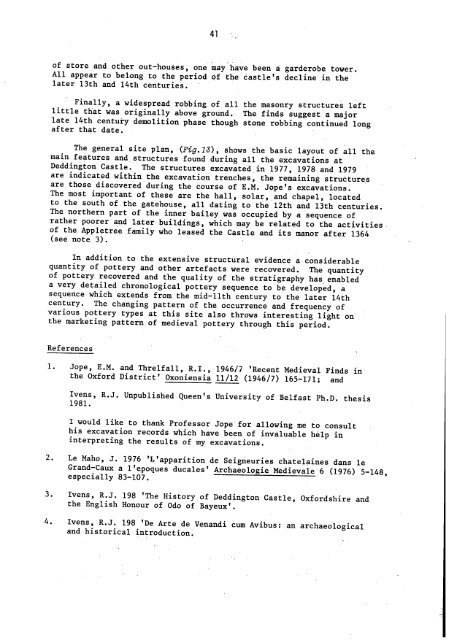CBA SMA\SMA 1983.PDF - Council for British Archaeology
CBA SMA\SMA 1983.PDF - Council for British Archaeology
CBA SMA\SMA 1983.PDF - Council for British Archaeology
Create successful ePaper yourself
Turn your PDF publications into a flip-book with our unique Google optimized e-Paper software.
41<br />
of store and other out-houses, one may have been a garderobe tower.<br />
All appear to belong to the period of the castle's decline in the<br />
later 13th and 14th centuries.<br />
Finally, a widespread robbing of all the masonry structures left<br />
little that was originally above ground. The finds suggest a major<br />
late 14th century demolition phase though stone robbing continued long<br />
after that date.<br />
The general site plan, (Fig.13), shows the basic layout of all the<br />
main features and structures found during all the excavations at<br />
Deddington Castle. The structures excavated in 1977, 1978 and 1979<br />
are indicated within the excavation trenches, the remaining structures<br />
are those discovered during the course of E.M. Jope's excavations.<br />
The most important of these are the hall, solar, and chapel, located<br />
to the south of the gatehouse, all dating to the 12th and 13th centuries.<br />
The northern part of the inner bailey was occupied by a sequence of<br />
rather poorer and later buildings, which may be related to the activities<br />
of the Appletree family who leased the Castle and its manor after 1364<br />
(see note 3).<br />
In addition to the extensive structural evidence a considerable<br />
quantity of pottery and other artefacts were recovered. The quantity<br />
of pottery recovered and the quality of the stratigraphy has enabled<br />
a very detailed chronological pottery sequence to be developed, a<br />
sequence which extends from the mid-llth century to the later 14th<br />
century. The changing pattern of the occurrence and frequency of<br />
various pottery types at this site also throws interesting light on<br />
the marketing pattern of medieval pottery through this period.<br />
References<br />
1.<br />
Jope, E.M. and Threlfall, R.I., 1946/7 'Recent Medieval Finds in<br />
the Ox<strong>for</strong>d District' Oxoniensia 11/12 (1946/7) 165-171; and<br />
Ivens, R.J. Unpublished Queen's University of Belfast Ph.D. thesis<br />
1981.<br />
I would like to thank Professor Jope <strong>for</strong> allowing me to consult<br />
his excavation records which have been of invaluable help in<br />
interpreting the results of my excavations.<br />
2. Le Maho, J. 1976 'L'apparition de Seigneuries chatelaines dans le<br />
Grand-Caux a l'epoques ducales' Archaeologie Medievale 6 (1976) 5-148,<br />
especially 83-107.<br />
3. Ivens, R.J.<br />
the English<br />
198 'The History of Deddington Castle, Ox<strong>for</strong>dshire and<br />
Honour of Odo of Bayeux'.<br />
4. Ivens, R.J. 198 'De Arte de Venandi cum Avibus: an archaeological<br />
and historical introduction.

















